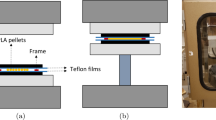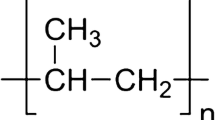Abstract
Polyurea is widely used in military and civilian applications, where long durations of exposure to the sun is common. Extended ultraviolet exposure can deteriorate the mechanical performance of the material to suboptimal levels. This study reports on the hyperelastic behavior of polyurea as a function of exposure duration to ultraviolet radiation. Initially, five sets of samples were continuously exposed to ultraviolet radiation for different durations up to 15 weeks. An additional set of samples were kept unexposed to report on the properties of an as-cast polyurea control. The samples were then loaded uniaxially in tension under a quasi-static loading rate (\(\dot{\epsilon }=0.0127{s}^{-1}\)) using a standard load frame. All exposed samples exhibited incremental color changes, which ranged from transparent yellow in virgin samples to opaque tan after 15 weeks of exposure. Changes in color were observed as early as 3 weeks of ultraviolet exposure. In addition to discoloration, crazing developed in all samples for exposure durations of 3 weeks and beyond. The size of the cracks increased as the duration of exposure continued. Postmortem examination indicated the initial microcracks grew due to loading and were visible to the naked eye. Discoloration and crazing were attributed to the formation of a thin ultraviolet-degraded layer due to the interaction of oxygen and ultraviolet light with the chromophoric groups in the polyurea macromolecule. The hyperelastic behavior was studied by fitting the stress–strain data into a four-term Ogden model. The overall hyperelastic behavior of polyurea remained unchanged even after 15 weeks of continuous ultraviolet exposure, where no permanent failure (except the ultraviolet-induced cracks) was recorded at the gauge length up to 250% strain. The values of the fitting parameters were nearly identical, supporting the conclusion of the insensitivity of polyurea hyperelastic behavior to ultraviolet radiation.




Similar content being viewed by others
References
1. Kim H, Citron J, Youssef G, et al (2012) Dynamic fracture energy of polyurea-bonded steel/E-glass composite joints. Mech Mater 45:10–19. doi:10.1016/j.mechmat.2011.08.017
Youssef G, Gupta V (2011) Dynamic tensile strength of polyurea. J Mater Res 27:494–499. doi:10.1557/jmr.2011.405
Jiao T, Clifton RJ, Grunschel SE (2006) High strain rate response of an elastomer. Shock Compression Condens Matter – 2005, Pts 1 2 845:809–812.
Zhao J, Knauss WG, Ravichandran G (2008) Applicability of the time – temperature superposition principle in modeling dynamic response of a polyurea. Mech Time Depend Mater 11:289–308. DOI:10.1007/s11043-008-9048-7
Barsoum RGS (2015) Elastomeric Polymers with High Rate Sensitivity: Applications in Blast, Shockwave, and Penetration Mechanics. William Andrew, Oxford
Xue L, Mock W, Belytschko T (2010) Penetration of DH-36 steel plates with and without polyurea coating. Mech Mater 42:981–1003. doi:10.1016/j.mechmat.2010.08.004
Bahei-El-Din Y a., Dvorak GJ, Fredricksen OJ (2006) A blast-tolerant sandwich plate design with a polyurea interlayer. Int J Solids Struct 43:7644–7658. doi:10.1016/j.ijsolstr.2006.03.021
Note BT (2014) Orientation-Dependent Impact Behavior of Polymer / EV A Bilayer Specimens at Long Wavelengths. Exp Mech 1–5. doi:10.1007/s11340-014-9854-6
Jason Keith Citron (University of California Los Angeles) Biomechanical Impact Management Using Polyurea. University of California, Los Angeles
Li C, Lua J (2009) A hyper-viscoelastic constitutive model for polyurea. Mater Lett 63:877–880. doi:10.1016/j.matlet.2009.01.055
Amirkhizi a. V., Isaacs J, McGee J, Nemat-Nasser S (2006) An experimentally-based viscoelastic constitutive model for polyurea, including pressure and temperature effects. Philos Mag 86:5847–5866. doi:10.1080/14786430600833198
Ito M, Nagai K (2008) Degradation issues of polymer materials used in railway field. Polym Degrad Stab 93:1723–1735. doi:10.1016/j.polymdegradstab.2008.07.011
White J, Turnbull A (1994) Weathering of polymers: mechanisms of degradation and stabilization, testing strategies and modelling. J Mater Sci 29:584. doi:10.1007/BF00445969
Qayyum MM, White JR (1986) The effect of weathering on residual stresses and mechanical properties in injection-moulded semi-crystalline polymers. J Mater Sci 21:2391–2402. doi:10.1007/BF01114283
Rottler J, Robbins M (2003) Growth, microstructure, and failure of crazes in glassy polymers. Phys Rev E 68:011801. doi: 10.1103/PhysRevB.68.011801
Kockott D (1989) Natural and artificial weathering of polymers. Polym. Degrad. Stab. 25:181–208. doi:10.1016/S0141-3910(89)81007-9
Scheirs J (2000) Compositional and failure analysis of polymers: a practical approach. Wiley, Chichester
Davis A, Sims D (1983) Weathering of polymers. Applied Science, London
Gigliotti M, Grandidier J, Lafarie-Frenot M (2011) Assessment of chemo-mechanical couplings in polymer matrix materials exposed to thermo-oxidative environments at high temperatures and under tensile loadings. Mech. Mater. 43: 431–443
Olivier L, Ho N, Grandidier J (2008) Characterization by ultra-micro indentation of an oxidized epoxy polymer: Correlation with the predictions of a kinetic model of oxidation. Polym. Degrad. 93:489–497 Doi:10.1016/j.polymdegradstab.2007.11.012
Whitten I, Youssef G (2016) The effect of ultraviolet radiation on ultrasonic properties of polyurea. Polym. Degrad. Stab. 123:88–93. doi:10.1016/j.polymdegradstab.2015.11.009
Youssef G, Whitten I (2016) Dynamic properties of ultraviolet-exposed polyurea. Mech Time-Dependent Mater 1–13. doi:10.1007/s11043-016-9333-9
Arruda EM, Boyce MC (1993) A three-dimensional constitutive model for the large stretch behavior of rubber elastic materials. J Mech Phys Solids 41:389–412. doi:10.1016/0022-5096(93)90013-6
Mooney M (1940) A theory of large elastic deformation. J Appl Phys 11:582–592. doi:10.1063/1.1712836
Treloar LRG (1949) Stresses and birefringence in rubber subjected to general homogeneous strain. Rubber Chem Technol 22:53–63. doi:10.5254/1.3542950
Ajit Mal SJS (1991) Deformation of Elastic Solids. Prentice Hall, Englewood Cliffs
Ogden R (1997) Non-linear elastic deformations. Dover Publications, Mineola
Roland CM, Twigg JN, Vu Y, Mott PH (2007) High strain rate mechanical behavior of polyurea. Polymer (Guildf) 48:574–578. doi:10.1016/j.polymer.2006.11.051
ASTM (2013) ASTM: D638, Standard test method for tensile properties of plastics. ASTM Stand 1–16. doi:10.1520/D0638-10.1
ASTM (2011) ASTM: D478/4798 M-11, Standard Practice for Accelerated Weathering Test Conditions and Procedures for Bituminous Materials (Xenon-Arc Method). ASTM Stand 1–3.
ASTM (2008) ASTM: D4799/4799 M, Standard Practice for Accelerated Weathering Test Conditions and Procedures for Bituminous Materials (Fluorescent UV, Water Spray, and Condensation Method). ASTM Stand 1–3.
Sarva SS, Deschanel S, Boyce MC, Chen W (2007) Stress-strain behavior of a polyurea and a polyurethane from low to high strain rates. Polymer (Guildf) 48:2208–2213. doi:10.1016/j.polymer.2007.02.058
Qayyum M, White J (1986) The effect of weathering on residual stresses and mechanical properties in injection-moulded semi-crystalline polymers. J Mater Sci 21:2391
Pochiraju K V., Tandon GP, Schoeppner G a. (2008) Evolution of stress and deformations in high-temperature polymer matrix composites during thermo-oxidative aging. Mech Time-Dependent Mater 12:45–68. doi:10.1007/s11043-007-9042-5
Pochiraju K, Tandon GP (2009) Interaction of oxidation and damage in high temperature polymeric matrix composites. Compos Part A Appl Sci Manuf 40:1931–1940. doi:10.1016/j.compositesa.2009.03.010
Acknowledgements
The research leading to these results was supported in part by the United States Department of Defense under Grant Agreement No. W911NF-14-1-0039. The authors also acknowledge the assistance of Dr. Steve Barlow, and use of equipment at the San Diego State University Electron Microscopy Facility acquired by NSF instrumentation grant DBI-0959908.
Author information
Authors and Affiliations
Corresponding author
Rights and permissions
About this article
Cite this article
Youssef, G., Brinson, J. & Whitten, I. The Effect of Ultraviolet Radiation on the Hyperelastic Behavior of Polyurea. J Polym Environ 26, 183–190 (2018). https://doi.org/10.1007/s10924-016-0933-x
Published:
Issue Date:
DOI: https://doi.org/10.1007/s10924-016-0933-x




